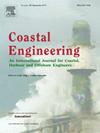Hazard-consistent scenario selection for long-term storm surge risk assessment over extended coastal regions
IF 4.2
2区 工程技术
Q1 ENGINEERING, CIVIL
引用次数: 0
Abstract
The recent destructive hurricane seasons and concerns related to the future influence of climate change have increased the relevance of coastal storm hazards and, in particular, of storm surge hazard estimation when discussing the resilience of coastal communities. This hazard is generally represented as surge inundation probabilities over a large number of individual locations in the geographic domain of interest, and is typically assessed utilizing an ensemble of storm scenarios (i.e., storm events) that are representative of the regional climatology. This paper investigates the storm ensemble selection within this setting, with the objective of identifying a small number of storm scenarios that are consistent with some chosen hazard descriptions over a large geographic region. Beyond the storm events, the occurrence rates (i.e., weights) are also updated. Following past works, a two-stage optimization is adopted for the storm selection. The inner-loop identifies the occurrence rates for a given storm subset, formulating the problem as a linear programming optimization for the sum of absolute deviation for the predicted hazard. The outer-loop searches for the best subset with the desired number of storms, adopting a genetic algorithm integer optimization for minimizing the aforementioned deviation. This work extends this implementation to extended coastal regions, with many locations of interest. In this case, it is computationally intractable to consider all the locations in the domain within the linear programming formulation, and for this reason, a subset of representative locations is chosen through cluster analysis. The hazard description for only these locations is used in the storm ensemble selection. For clustering, different strategies using correlation between locations based on geospatial information, surge response, or a combination of both are examined. Additionally, the correlation in the hazard description is better integrated into the storm selection by establishing a modification of the objective function adopted for the outer optimization loop. Applications to different North Atlantic coastal domains are presented as case studies.
为扩展沿海区域的长期风暴潮风险评估选择与灾害一致的情景
最近几个具有破坏性的飓风季节以及对未来气候变化影响的担忧,增加了沿海风暴 灾害的相关性,特别是在讨论沿海社区抗灾能力时,风暴潮灾害估算的相关性。这种灾害通常表现为相关地理区域内大量单个地点的风暴潮淹没概率,通常利用能代表区域气候的风暴场景(即风暴事件)组合进行评估。本文研究了在这种情况下的风暴集合选择,目的是确定少量风暴情景,这些情景与所选的大地理区域内的某些灾害描述相一致。除风暴事件外,还更新了发生率(即权重)。根据以往的工作经验,风暴选择采用两阶段优化法。内环识别给定风暴子集的发生率,将问题表述为预测危害绝对偏差总和的线性编程优化。外环采用遗传算法整数优化,最小化上述偏差,寻找具有所需风暴次数的最佳子集。这项工作将这一实施方法扩展到沿海地区,包括许多感兴趣的地点。在这种情况下,在线性规划公式中考虑域内的所有地点在计算上是难以实现的,因此,通过聚类分析选择了一个有代表性的地点子集。在选择风暴集合时,只使用这些地点的灾害描述。在聚类分析中,根据地理空间信息、浪涌响应或两者的结合,利用地点之间的相关性来研究不同的策略。此外,通过修改外部优化环路采用的目标函数,将灾害描述中的相关性更好地融入风暴选 择中。案例研究介绍了北大西洋不同沿海地区的应用情况。
本文章由计算机程序翻译,如有差异,请以英文原文为准。
求助全文
约1分钟内获得全文
求助全文
来源期刊

Coastal Engineering
工程技术-工程:大洋
CiteScore
9.20
自引率
13.60%
发文量
0
审稿时长
3.5 months
期刊介绍:
Coastal Engineering is an international medium for coastal engineers and scientists. Combining practical applications with modern technological and scientific approaches, such as mathematical and numerical modelling, laboratory and field observations and experiments, it publishes fundamental studies as well as case studies on the following aspects of coastal, harbour and offshore engineering: waves, currents and sediment transport; coastal, estuarine and offshore morphology; technical and functional design of coastal and harbour structures; morphological and environmental impact of coastal, harbour and offshore structures.
 求助内容:
求助内容: 应助结果提醒方式:
应助结果提醒方式:


